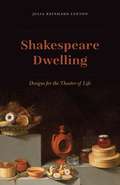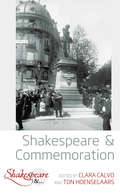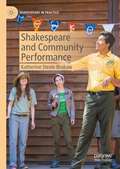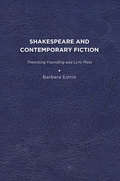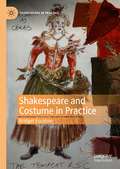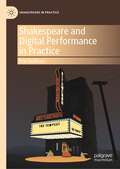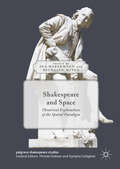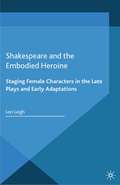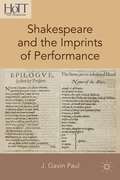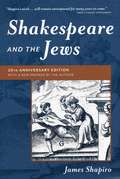- Table View
- List View
Shakespeare Dwelling: Designs for the Theater of Life
by Julia Reinhard LuptonGreat halls and hovels, dove-houses and sheepcotes, mountain cells and seaside shelters—these are some of the spaces in which Shakespearean characters gather to dwell, and to test their connections with one another and their worlds. Julia Reinhard Lupton enters Shakespeare’s dwelling places in search of insights into the most fundamental human problems. Focusing on five works (Romeo and Juliet, Macbeth, Pericles, Cymbeline, and The Winter’s Tale), Lupton remakes the concept of dwelling by drawing on a variety of sources, including modern design theory, Renaissance treatises on husbandry and housekeeping, and the philosophies of Hannah Arendt and Martin Heidegger. The resulting synthesis not only offers a new entry point into the contemporary study of environments; it also shows how Shakespeare’s works help us continue to make sense of our primal creaturely need for shelter.
Shakespeare On Film
by Russell JacksonFilm adaptations of Shakespeare's plays are increasingly popular and now figure prominently in the study of his work and its reception. This lively Companion is a collection of critical and historical essays on the films adapted from, and inspired by, Shakespeare's plays. An international team of leading scholars discuss Shakespearean films from a variety of perspectives: as works of art in their own right; as products of the international movie industry; in terms of cinematic and theatrical genres; and as the work of particular directors from Laurence Olivier and Orson Welles to Franco Zeffirelli and Kenneth Branagh. They also consider specific issues such as the portrayal of Shakespeare's women and the supernatural. The emphasis is on feature films for cinema, rather than television, with strong coverage of Hamlet, Richard III, Macbeth, King Lear and Romeo and Juliet. A guide to further reading and a useful filmography are also provided.
Shakespeare Performance Studies
by W. B. WorthenTaking a 'performance studies' perspective on Shakespearean theatre, W. B. Worthen argues that the theatrical event represents less an inquiry into the presumed meanings of the text than an effort to frame performance as a vehicle of cultural critique. Using contemporary performances as test cases, Worthen explores the interfaces between the origins of Shakespeare's writing as literature and as theatre, the modes of engagement with Shakespeare's plays for readers and spectators, and the function of changing performance technologies on our knowledge of Shakespeare. This book not only provides the material for performance analysis, but places important contemporary Shakespeare productions in dialogue with three influential areas of critical discourse: texts and authorship, the function of character in cognitive theatre studies, and the representation of theatre and performing in the digital humanities. This book will be vital reading for scholars and advanced students of Shakespeare and of Performance Studies.
Shakespeare Survey: Shakespeare Survey
by Peter Holland Emma Peter Smith Emma Smith HollandShakespeare Survey is a yearbook of Shakespeare studies and production. Since 1948 Survey has published the best international scholarship in English and many of its essays have become classics of Shakespeare criticism. Each volume is devoted to a theme, or play, or group of plays; each also contains a section of reviews of the previous year's textual and critical studies and of major British performances. The books are illustrated with a variety of Shakespearean images and production photographs. The current editor of Survey is Peter Holland. The first eighteen volumes were edited by Allardyce Nicoll, numbers 19-33 by Kenneth Muir and numbers 34-52 by Stanley Wells. The virtues of accessible scholarship and a keen interest in performance, from Shakespeare's time to our own, have characterised the journal from the start. For the first time, numbers 1-50 are being reissued in paperback, available separately and as a set.
Shakespeare Without Tears
by Margaret WebsterA prominent producer-director of Shakespeare's plays writes with wit and verve about the Elizabethan theater and subsequent modifications in theatrical practice, differences between actors and audiences in Shakespeare's day and ours, and more "There is not an obscure or otherwise dull page in the book." -- N.Y. Times Book Review.
Shakespeare and Antiblack World-Making (Reproducing Shakespeare)
by Matthieu ChapmanThis book is about Shakespeare&’s role in sustaining the antiblack paradigm of modernity. This work re-reads both Shakespearean texts and performances from the 16th century to the present to argue that American and English societies have deployed Shakespeare for four hundred years as a mechanism to construct and reinforce paradigmatic antiblackness. Framed within the author&’s experiences as a Black scholar, actor, and director of Shakespeare and using both contemporary Critical Race Theory (CRT), as well as Pre-Modern Critical Race Studies (PCRS), this book uses civil society&’s engagement with and performance of Shakespeare in various times and places to reveal the continuum of antiblackness that predates chattel slavery in America and contributes to antiblack world-making across oceans and centuries.
Shakespeare and Celebrity Cultures (Routledge Advances in Theatre & Performance Studies)
by Jennifer HollThis book argues that Shakespeare and various cultures of celebrity have enjoyed a ceaselessly adaptive, symbiotic relationship since the final decade of the sixteenth century, through which each entity has contributed to the vitality and adaptability of the other. In five chapters, Jennifer Holl explores the early modern culture of theatrical celebrity and its resonances in print and performance, especially in Shakespeare’s interrogations of this emerging phenomenon in sonnets and histories, before moving on to examine the ways that shifting cultures of stage, film, and digital celebrity have perpetually recreated the Shakespeare, or even the #shakespeare, with whom audiences continue to interact. Situated at an intersection of multiple critical conversations, this book will be of great interest to scholars and graduate students of Shakespeare and Shakespearean appropriations, early modern theater, and celebrity studies.
Shakespeare and Child's Play: Performing Lost Boys on Stage and Screen
by Carol Chillington RutterShakespeare wrote more than fifty parts for children, amounting to the first comprehensive portrait of childhood in the English theatre. Focusing mostly on boys, he put sons against fathers, servants against masters, innocence against experience, testing the notion of masculinity, manners, morals, and the limits of patriarchal power. He explored the nature of relationships and ideas about parenting in terms of nature and nurture, permissiveness and discipline, innocence and evil. He wrote about education, adolescent rebellion, delinquency, fostering, and child-killing, as well as the idea of the redemptive child who ‘cures’ diseased adult imaginations. ‘Childness’ – the essential nature of being a child – remains a vital critical issue for us today. In Shakespeare and Child’s-Play Carol Rutter shows how recent performances on stage and film have used the range of Shakespeare’s insights in order to re-examine and re-think these issues in terms of today’s society and culture.
Shakespeare and Classic Works in the Classroom: Teaching Pre-20th Century Literature at KS2 and KS3
by Dennis CarterWith supportive guidelines for Key Stages 2 and 3 this book offers active approaches for teaching pre-twentieth century literature with confidence. Key texts including The Odyssey, Hamlet and The Rime of the Ancient Mariner are explained in a very practical and accessible way. This text allows for creativity amongst pupils at the same time as improving their reading and writing abilities within the literacy strategy objectives and KS3 English framework guidelines. The author looks to develop an active pedagogy that encompasses the literacy strategy, the KS3 English framework and the creative arts. Using case studies from primary and secondary school projects a series of lessons are proposed for each year group from Year 4 though to Year 8. The lessons cover poetry, drama, story and the novel.
Shakespeare and Commedia dell'Arte: Play by Play
by Artemis PreeshlShakespeare and Commedia dell’Arte examines the ongoing influence of commedia dell’arte on Shakespeare’s plays. Exploring the influence of commedia dell’arte improvisation, sight gags, and wordplay on the development of Shakespeare’s plays, Artemis Preeshl blends historical research with extensive practical experience to demonstrate how these techniques might be applied when producing some of Shakespeare's best-known works today. Each chapter focuses on a specific play, from A Midsummer Night’s Dream to The Winter’s Tale, drawing out elements of commedia dell’arte style in the playscripts and in contemporary performance. Including contemporary directors’ notes and interviews with actors and audience members alongside Elizabethan reviews, criticism, and commentary, Shakespeare and Commedia dell’Arte presents an invaluable resource for scholars and students of Renaissance theatre.
Shakespeare and Commemoration: Commemoration And Cultural Memory (Shakespeare & #2)
by Ton Hoenselaars Clara CalvoMemory and commemoration play a vital role not only in the work of Shakespeare, but also in the process that has made him a world author. As the contributors of this collection demonstrate, the phenomenon of commemoration has no single approach, as it occurs on many levels, has a long history, and is highly unpredictable in its manifestations. With an international focus and a comparative scope that explores the afterlives also of other artists, this volume shows the diverse modes of commemorative practices involving Shakespeare. Delving into these “cultures of commemoration,” it presents keen insights into the dynamics of authorship, literary fame, and afterlives in its broader socio-historical contexts.
Shakespeare and Community Performance (Shakespeare in Practice)
by Katherine Steele BrokawThis book explores how productions of Shakespearean plays create meaning in specific communities, with special attention to issues of access, adaptation, and activism. Instead of focusing on large professional companies, it analyzes performances put on by community theatres and grassroots companies, and in applied drama projects. It looks at Shakespearean productions created by marginalized populations in Greater London, Harlem, and Los Angeles, a Hamlet staged in the remote Faroe Islands, and eco-theatre made in California’s Yosemite National Park. The book investigates why different communities perform Shakespeare, and what challenges, opportunities, and triumphs accompany the processes of theatrical production for both the artists and the communities in which they are embedded.
Shakespeare and Contemporary Fiction: Theorizing Foundling and Lyric Plots
by Barbara L. EstrinIn the first book to use fiction as theory, Barbara L. Estrin reverses chronological direction, beginning with contemporary novels to arrive at a re-visioned Shakespeare, uncovering a telling difference in the stories that script us and that influence our political unconscious in ways that have never been explored in literary-critical interpretations. Describing the animus against foreign blood, central to the dynamic of the foundling and lyric plots that form the nexus of her study, Estrin describes how late modern writers change those plots. Reading backward through the theoretical lens of their revisions allows us to rethink the Shakespeare we thought we knew. That innovative methodology, in turn, encourages us to read forward again with different tellings, ones that challenge the mythological homogeneity of the traditional classifications and that suggest new formulaic paradigms. With close readings of four contemporary novels and three Shakespeare plays, Estrin identifies the cultural walls that contribute to political gate-keeping as she chronicles the connection between plot variations and gender revisionism in the work of Caryl Phillips, Liz Jensen, Anne Michaels, and W.G. Sebald, as well as two film-makers (Mona Hatoum and Mieke Bal) who demonstrate an understanding that mythical repercussions prove dangerous in the twentieth and twenty-first centuries even as they suggest how the heritage shaping their work, and to which they are themselves drawn, in turn proposes an alternative Shakespeare, one who frees us to ask other questions: At the time that the nation state was beginning to coalesce, what does Shakespeare’s frequent use of the foundling plot and his significant variations portend? How does his infusion of a revised lyric dynamic in The Merchant of Venice, Othello and The Winter’s Tale change our reading of plays where the two plots coalesce as they do in the contemporary novels that shape Estrin’s late modern interpretations? All the works in this study share the underlying premise that the connection between cultural origins and political destinies is reciprocal and that it is necessary and possible to transform the constructs—in memory and imagination—that continue to shape our lives. Published by University of Delaware Press. Distributed worldwide by Rutgers University Press.
Shakespeare and Costume in Practice (Shakespeare in Practice)
by Bridget EscolmeWhat is the role of costume in Shakespeare production? Shakespeare and Costume in Practice argues that costume design choices are central not only to the creation of period setting and the actor’s work on character, but to the cultural, political, and psychological meanings that the theatre makes of Shakespeare. The book explores questions about what the first Hamlet looked like in his mourning cloak; how costumes for a Shakespeare comedy can reflect or critique the collective nostalgias a culture has for its past; how costume and casting work together to ask new questions about Shakespeare and race. Using production case studies of Hamlet, Much Ado About Nothing, and The Tempest, the book demonstrates that costume design can be a site of experimentation, playfulness, and transgression in the theatre – and that it can provoke audiences to think again about what power, race, and gender look like on the Shakespearean stage.
Shakespeare and Digital Performance in Practice (Shakespeare in Practice)
by Erin SullivanShakespeare and Digital Performance in Practice explores the impact of digital technologies on the theatrical performance of Shakespeare in the twenty-first century, both in terms of widening cultural access and developing new forms of artistry. Through close analysis of dozens of productions, both high-profile and lesser known, it examines the rise of live broadcasting and recording in the theatre, the growing use of live video feeds and dynamic projections on the mainstream stage, and experiments in born-digital theatre-making, including social media, virtual reality, and video-conferencing adaptations. In doing so, it argues that technologically adventurous performances of Shakespeare allow performers and audiences to test what they believe theatre to be, as well as to reflect on what it means to be present—with a work of art, with others, with oneself—in an increasingly online world.
Shakespeare and Indian Cinemas: "Local Habitations" (Routledge Studies in Shakespeare)
by Poonam Trivedi Paromita ChakravartiThis book is the first to explore the rich archive of Shakespeare in Indian cinemas, including less familiar, Indian language cinemas to contribute to the assessment of the expanding repertoire of Shakespeare films worldwide. Essays cover mainstream and regional Indian cinemas such as the better known Tamil and Kannada, as well as the less familiar regions of the North Eastern states. The volume visits diverse filmic genres, starting from the earliest silent cinema, to diasporic films made for global audiences, television films, independent films, and documentaries, thus expanding the very notion of ‘Indian cinema’ while also looking at the different modalities of deploying Shakespeare specific to these genres. Shakespeareans and film scholars provide an alternative history of the development of Indian cinemas through its negotiations with Shakespeare focusing on the inter-textualities between Shakespearean theatre, regional cinema, performative traditions, and literary histories in India. The purpose is not to catalog examples of Shakespearean influence but to analyze the interplay of the aesthetic, historical, socio-political, and theoretical contexts in which Indian language films have turned to Shakespeare and to what purpose. The discussion extends from the content of the plays to the modes of their cinematic and intermedial translations. It thus tracks the intra–Indian flows and cross-currents between the various film industries, and intervenes in the politics of multiculturalism and inter/intraculturalism built up around Shakespearean appropriations. Contributing to current studies in global Shakespeare, this book marks a discursive shift in the way Shakespeare on screen is predominantly theorized, as well as how Indian cinema, particularly ‘Shakespeare in Indian cinema’ is understood.
Shakespeare and Sexuality in the Comedy of Morecambe & Wise (Palgrave Studies in Comedy)
by Stephen HamrickContextualizing the duo’s work within British comedy, Shakespeare criticism, the history of sexuality, and their own historical moment, this book offers the first sustained analysis of the 20th Century’s most successful double-act. Over the course of a forty-four-year career (1940-1984), Eric Morecambe & Ernie Wise appropriated snippets of verse, scenes, and other elements from seventeen of Shakespeare’s plays more than one-hundred-and-fifty times. Fashioning a kinder, more inclusive world, they deployed a vast array of elements connected to Shakespeare, his life, and institutions. Rejecting claims that they offer only nostalgic escapism, Hamrick analyses their work within contemporary contexts, including their engagement with many forms and genres, including Variety, the heritage industry, journalism, and more. ‘The Boys’ deploy Shakespeare to work through issues of class, sexuality, and violence. Lesbianism, drag, gay marriage, and a queer aesthetics emerge, helping to normalize homosexuality and complicate masculinity in the ‘permissive’ 1960s.
Shakespeare and Social Engagement (Shakespeare & #10)
by Rowan Mackenzie and Robert ShaughnessyShakespeare’s roots in applied and participatory performance practices have been recently explored within a wide variety of educational, theatrical and community settings. Shakespeare and Social Engagement explores these settings, as well as audiences who have largely been excluded from existing accounts of Shakespeare’s performance history. The contributions in this collected volume explore the complicated and vibrant encounters between a canonical cultural force and work that frequently characterizes itself as inclusive and egalitarian.
Shakespeare and Space
by Ina Habermann Michelle WitenThis collection offers an overview of the ways in which space has become relevant to the study of Shakespearean drama and theatre. It distinguishes various facets of space, such as structural aspects of dramatic composition, performance space and the evocation of place, linguistic, social and gendered spaces, early modern geographies, and the impact of theatrical mobility on cultural exchange and the material world. These facets of space are exemplified in individual essays. Throughout, the Shakespearean stage is conceived as a topological 'node', or interface between different times, places and people - an approach which also invokes Edward Soja's notion of 'Thirdspace' to describe the blend between the real and the imaginary characteristic of Shakespeare's multifaceted theatrical world. Part Two of the volume emphasises the theatrical mobility of Hamlet - conceptually from an anthropological perspective, and historically in the tragedy's migrations to Germany, Russia and North America.
Shakespeare and Tourism (Routledge Advances in Theatre & Performance Studies)
by Valerie Clayman Pye Robert OrmsbyShakespeare and Tourism provides a dialogical mapping of Shakespeare studies and touristic theory through a collection of essays by scholars on a wide range of material. This volume examines how Shakespeare tourism has evolved since its inception, and how the phenomenon has been influenced and redefined by performance studies, the prevalence of the World Wide Web, developments in technology, and the globalization of Shakespearean performance. Current scholarship recognizes Shakespearean tourism as a thriving international industry, the result of centuries of efforts to attribute meanings associated with the playwright’s biography and literary prestige to sites for artistic pilgrimage and the consumption of cultural heritage. Through bringing Shakespeare and tourism studies into more explicit contact, this collection provides readers with a broad base for comparisons across time and location, and thereby encourages a thorough reconsideration of how we understand both fields.
Shakespeare and the Embodied Heroine: Staging Female Characters in the Late Plays and Early Adaptations (Palgrave Shakespeare Studies)
by L. LeighShakespeare and the Embodied Heroine is a bold new investigation of Shakespeare's female characters using the late plays and the early adaptations written and staged during the seventeenth and eighteenth century.
Shakespeare and the Ethics of War (Shakespeare & #5)
by Patrick GrayHow does Shakespeare represent war? This volume reviews scholarship to date on the question and introduces new perspectives, looking at contemporary conflict through the lens of the past. Through his haunting depiction of historical bloodshed, including the Trojan War, the fall of the Roman Republic, and the Wars of the Roses, Shakespeare illuminates more recent political violence, ranging from the British occupation of Ireland to the Spanish Civil War, the Balkans War, and the past several decades of U. S. military engagement in Iraq and Afghanistan. Can a war be just? What is the relation between the ruler and the ruled? What motivates ethnic violence? Shakespeare’s plays serve as the frame for careful explorations of perennial problems of human co-existence: the politics of honor, the ethics of diplomacy, the responsibility of non-combatants, and the tension between idealism and Realpolitik.
Shakespeare and the Imprints of Performance (History Of Text Technologies)
by J. Gavin PaulShakespeare and the Imprints of Performance.
Shakespeare and the Imprints of Performance (History of Text Technologies)
by J. Gavin PaulWithin the study of drama, the question of how to relate text and performance—and what interpretive tools are best suited to analyzing them—is a longstanding and contentious one. Most scholars agree that reading a printed play is a means of dramatic realization absolutely unlike live performance, but everything else beyond this premise is contestable: how much authority to assign to playwrights, the extent to which texts and readings determine performance, and the capability of printed plays to communicate the possibilities of performance. Without denying that printed plays distort and fragment performance practice, this book negotiates an intractable debate by shifting attention to the ways in which these inevitable distortions can nevertheless enrich a reader's awareness of a play's performance potentialities. As author J. Gavin Paul demonstrates, printed plays can be more meaningfully engaged with actual performance than is typically assumed, via specific editorial principles and strategies. Focusing on the long history of Shakespearean editing, he develops the concept of the performancescape: a textual representation of performance potential that gives relative shape and stability to what is dynamic and multifarious.
Shakespeare and the Jews
by James ShapiroFirst published in 1996, James Shapiro's pathbreaking analysis of the portrayal of Jews in Elizabethan England challenged readers to recognize the significance of Jewish questions in Shakespeare's day. From accounts of Christians masquerading as Jews to fantasies of settling foreign Jews in Ireland, Shapiro's work delves deeply into the cultural insecurities of Elizabethans while illuminating Shakespeare's portrayal of Shylock in The Merchant of Venice. In a new preface, Shapiro reflects upon what he has learned about intolerance since the first publication of Shakespeare and the Jews.
